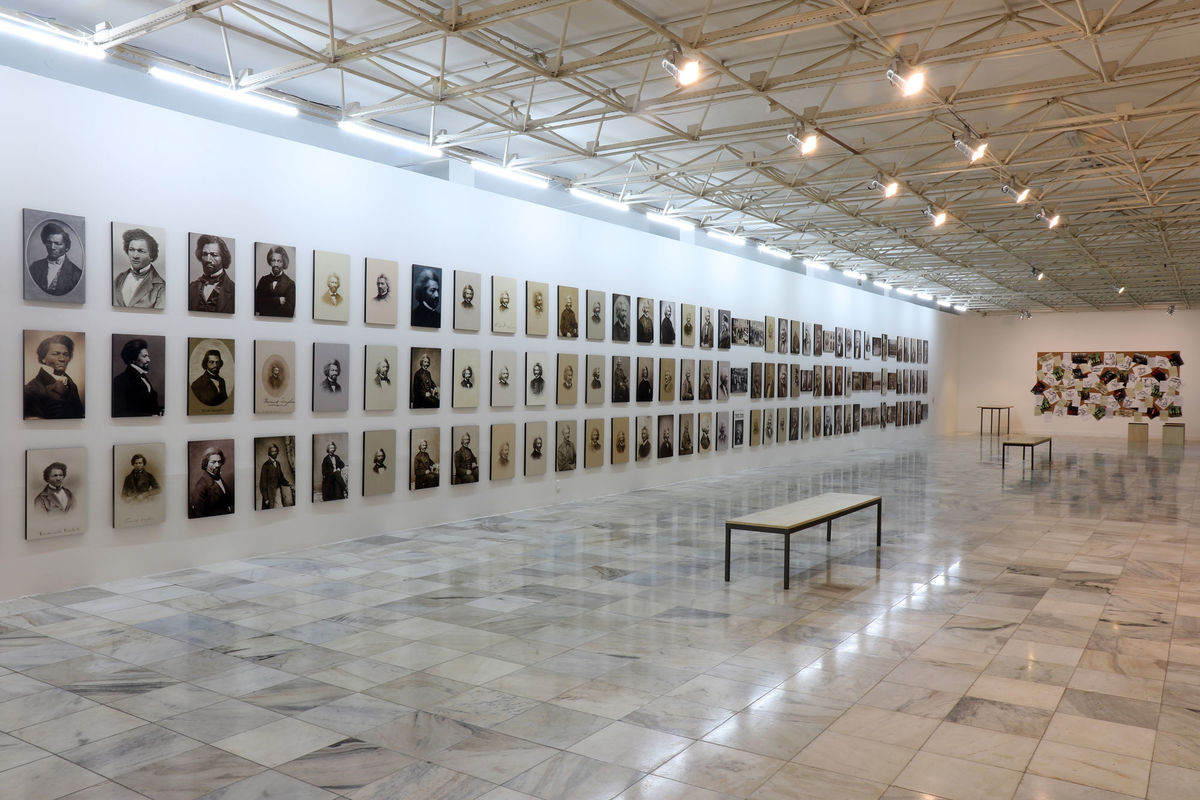Artistas
The 34th Bienal traveling exhibition in Belo Horizonte (MG) takes place from July 5 to September 25, 2022, in Palácio das Artes, through a partnership with Fundação Clóvis Salgado and APPA – Arts and Culture. This year, the exhibition in the city revolves around three statements: O sino de Ouro Preto [The Bell from Ouro Preto], Os retratos de Frederick Douglass [The Portraits of Frederick Douglass], and A ronda da morte de Hélio Oiticica [The death round by Hélio Oiticica].
The statement The Bell from Ouro Preto refers to the bronze bell from Nossa Senhora do Rosário dos Homens Brancos chapel, located in Ouro Preto (Minas Gerais), whose belfry bears a bronze bell, cast in Germany in 1750. It is said that, in April 21 of 1792, this bell was the only one in all colony to toll, in an openly disobedience to the order that forbade tributes to the crown's enemies, a ring of sorrow for the execution of Tiradentes, the only member of Inconfidência Mineira whose death sentence was not revoked. With the independence of Brazil and the Proclamation of the Republic, the Minas Gerais’ martyr was declared a national hero, and , and the bell that tolled for him became a symbol of the fight for the country’s sovereignty, to the point that in 1960, in another April 21, it was taken to Brasília, hoisted besides a replica of the cross used on the first mass in Brazil and rang for the inauguration of the new capital.
On the 34ª Bienal, this statement refers to questions like: what does it mean, today, to look back to this bell so strongly charged by colonial history, to feel the time that continues to settle on it? Which echoes from Brazil and the world arrive, today, at the old Vila Rica and resound in the bronze of this bell?
Another core of the exhibition in Belo Horizonte is conceived after the statement The Portraits of Frederick Douglass. Douglass was a North American public figure, journalist, writer, speaker, and one of the main exponents of the fight for the abolition of slavery. Until today his portraits travel around the world as a symbol of justice and freedom. Therefore, under Douglas’ piercing and challenging glance, this statement brings artists and works which address colonial processes, displacements, violence and resistance that marked and still mark the life of millions around the world.
The 3rd statement present in Belo Horizonte’s exhibition is A Ronda da Morte by Hélio Oiticica, which starts from an unrealized work, planned by Oiticica himself during the military dictatorship. Artist forged in the experimental environment of Rio de Janeiro in the 1950s, he has always sought to break the limits of traditional languages in order to deepen the art experience as an integral part of collective life.
In an interview after his return, the artist spoke about the sadness of realizing he could no longer meet many of the people he befriended in Rio’s favelas and samba parties in the mid-1960s, assigning these absences to the State’s systematic annihilation of part of the population. A Ronda da Morte – as well as the impossibility of making it happen – continues to synthesize the perversity of simulating normality while genocides are happening. But it also highlights that historical flows and dynamics are not enclosed in the periodization we find in books. The past lives in the present, constituting challenges and inspiring struggles that will be fundamental for building the yet-to-come..
34th Bienal de São Paulo - Though it's dark still I sing
Traveling exhibition program
Palácio das Artes
Belo Horizonte (MG)
July 5 – September 25 2022
Av. Afonso Pena, 1537 – Centro, Belo Horizonte (MG)
monday to saturday, from 9 am to 9pm
sunday 2pm to 8pm
Free entrance
![Obras de [works of] Seba Calfuqueo e [and] Ana Adamović, Palácio das Artes © Paulo Lacerda / Fundação Clóvis Salgado](http://imgs.fbsp.org.br/files/eb4c83fd7ba603ce7d5ef8f8c2a9511c.jpg)
![Obra de [work of] Seba Calfuqueo, Palácio das Artes © Paulo Lacerda / Fundação Clóvis Salgado](http://imgs.fbsp.org.br/files/571e4ada977d411bdf49f94141a0cd69.jpg)
![Obras de [works of] Regina Silveira e [and] Nina Beier, Palácio das Artes © Paulo Lacerda / Fundação Clóvis Salgado](http://imgs.fbsp.org.br/files/ffa383f02f3a836915af0d222998bd9c.jpg)
![Obras de [works of] Clara Ianni, Palácio das Artes © Paulo Lacerda / Fundação Clóvis Salgado](http://imgs.fbsp.org.br/files/90024d86e72d2804a8910e93bcb51b40.jpg)
![Obra de [work of] Lothar Baumgarten, Palácio das Artes © Paulo Lacerda / Fundação Clóvis Salgado](http://imgs.fbsp.org.br/files/23a047aac9d711143f1d7900487a302e.jpg)
![Obras de [works of] Anna-Bella Papp e [and] Eleonore Koch, Palácio das Artes © Paulo Lacerda / Fundação Clóvis Salgado](http://imgs.fbsp.org.br/files/ea58c052a797d18d77e920bed32d9496.jpg)
![Obras de [works of] Eleonore Koch, Anna-Bella Papp e [and] Nina Beier, Palácio das Artes © Paulo Lacerda / Fundação Clóvis Salgado](http://imgs.fbsp.org.br/files/b1d537781bb123e0fc2cdc53225bed17.jpg)
![Obras de [works of] Noa Eshkol, Palácio das Artes © Paulo Lacerda / Fundação Clóvis Salgado](http://imgs.fbsp.org.br/files/2502a1c1e84fada424083c694e8af54b.jpg)
![Obras de [works of] Daniel de Paula e [and] Noa Eshkol, Palácio das Artes © Paulo Lacerda / Fundação Clóvis Salgado](http://imgs.fbsp.org.br/files/ab2960dace1aa8c2706711f845304be3.jpg)
![Obra de [work of] Lydia Ourahmane, Palácio das Artes © Paulo Lacerda / Fundação Clóvis Salgado](http://imgs.fbsp.org.br/files/096ed2e9b92e80870487904da47c36aa.jpg)

![Obra de [work of] Tony Cokes, Palácio das Artes © Paulo Lacerda / Fundação Clóvis Salgado](http://imgs.fbsp.org.br/files/fff9529145136c4e4c4b1197f9710b84.jpg)
![Obra de [work of] Neo Muyanga, Palácio das Artes © Paulo Lacerda / Fundação Clóvis Salgado](http://imgs.fbsp.org.br/files/3bda9bbf06eb38de609e1245da49ff65.jpg)
![Obras de [works of] Paulo Kapela, Palácio das Artes © Paulo Lacerda / Fundação Clóvis Salgado](http://imgs.fbsp.org.br/files/1a1c712f7380639df0b8fbdb5905f14d.jpg)
![Obra de [work of] Andrea Fraser, Palácio das Artes © Paulo Lacerda / Fundação Clóvis Salgado](http://imgs.fbsp.org.br/files/13b4e0fa835ac5b291443432673f81eb.jpg)
![Obras de [works of] Daiara Tukano e [and] Jaider Esbell, Palácio das Artes © Paulo Lacerda / Fundação Clóvis Salgado](http://imgs.fbsp.org.br/files/524d861ec1c5f1b4816c6e6a79c741ad.jpg)
![Obra de [work of] Arjan Martins, Palácio das Artes © Paulo Lacerda / Fundação Clóvis Salgado](http://imgs.fbsp.org.br/files/855c044207a8e007a4efa514d40c0961.jpg)
![Vista da itinerância da 34ª Bienal de São Paulo [view of the 34th Bienal de São Paulo's travelling exhibition], Palácio das Artes © Paulo Lacerda / Fundação Clóvis Salgado](http://imgs.fbsp.org.br/files/dcceaa8cf27ebfb69aa758aea0bf1b6e.jpg)

